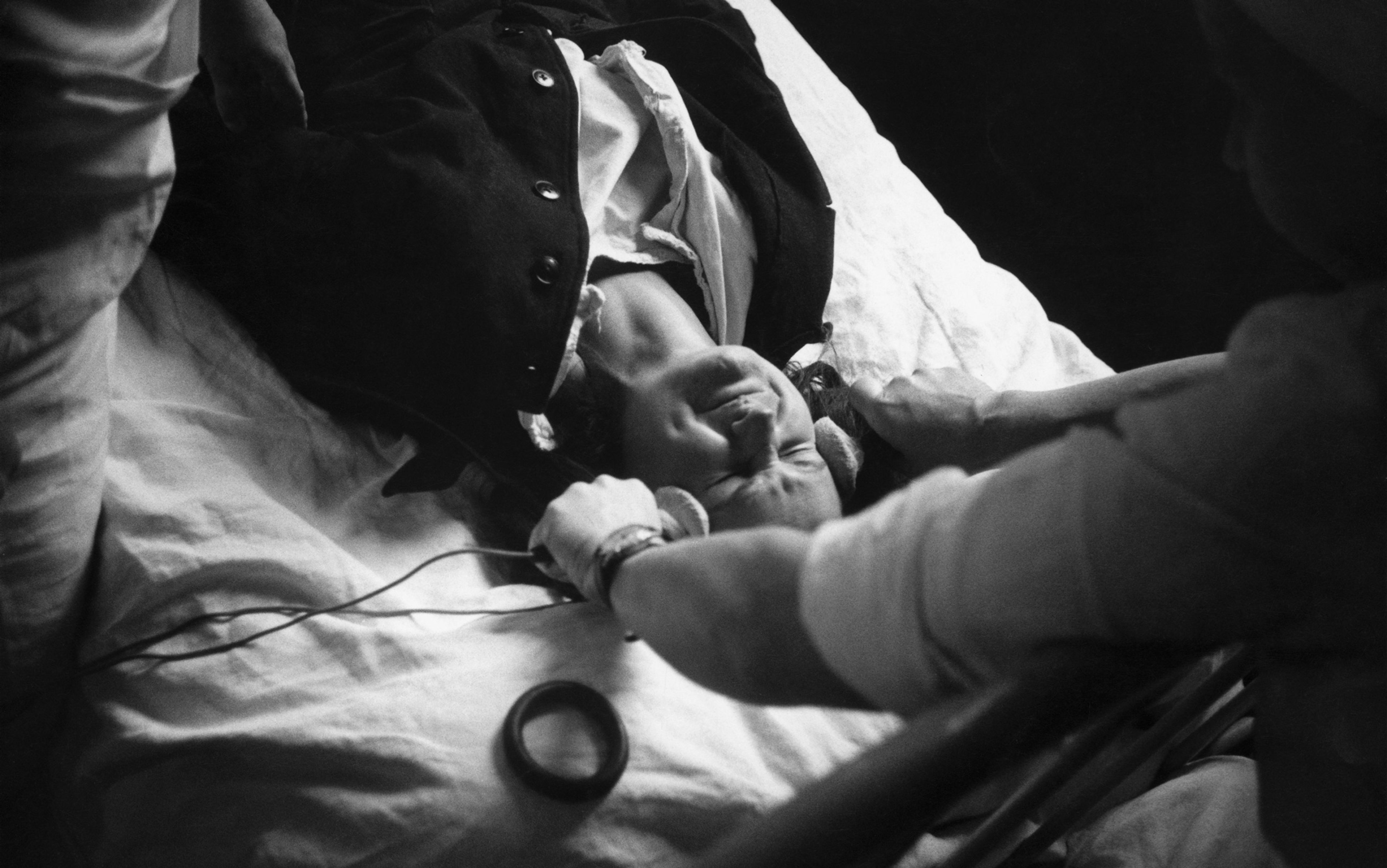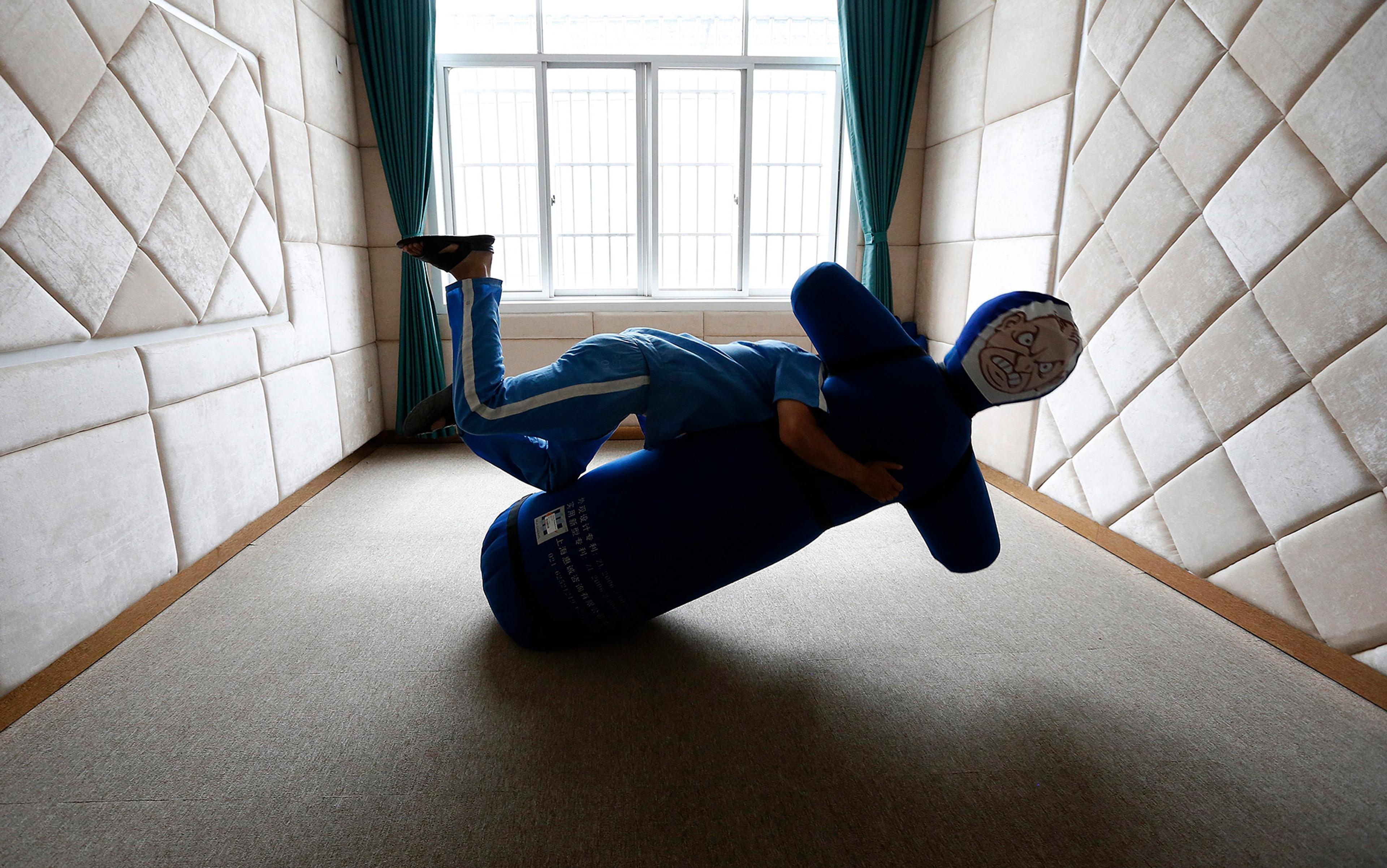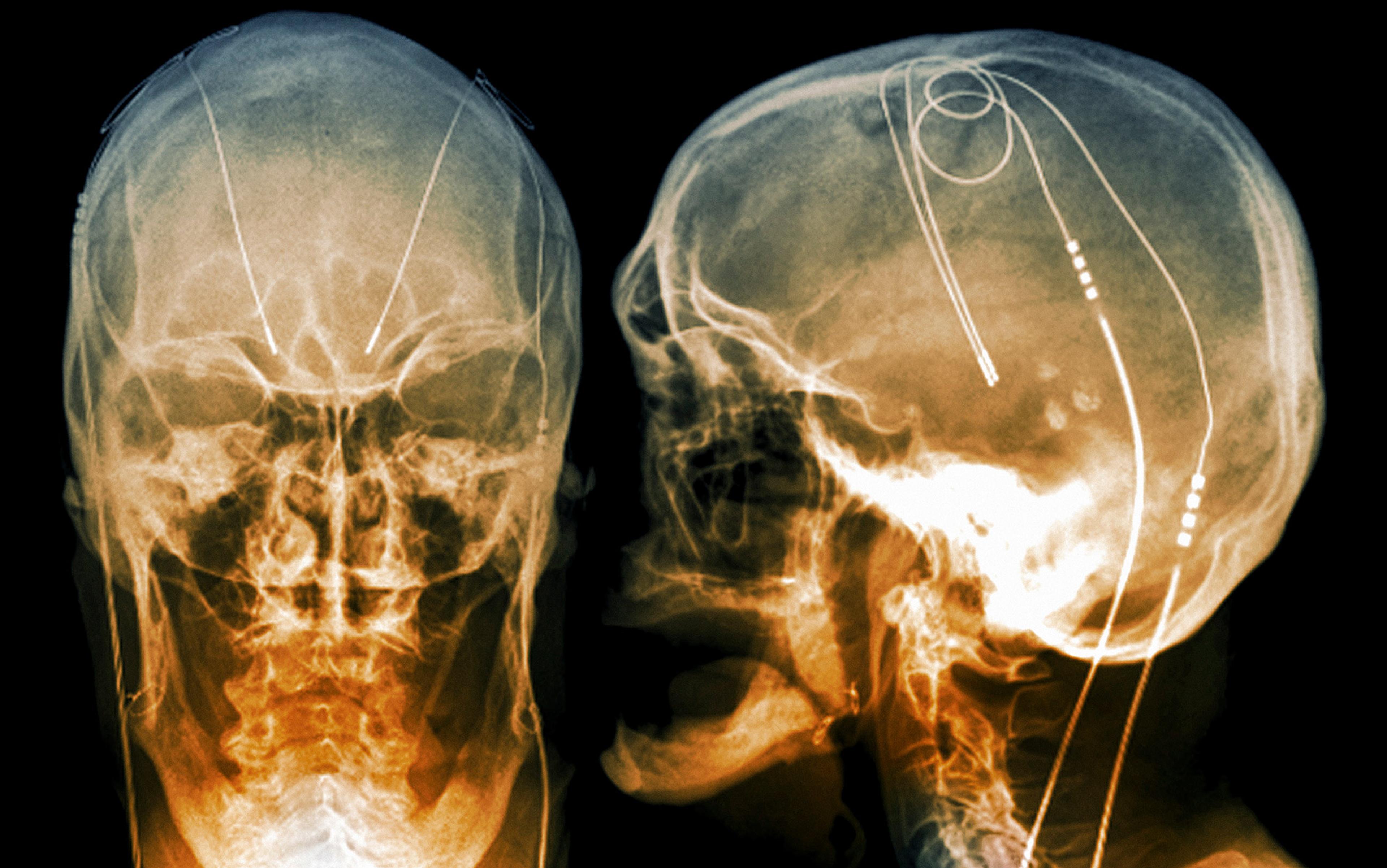In the early 1970s, I was a naive 21-year-old, in love with my first job since graduating university, as a nursing aide on a psychiatric ward in New York. Three times a week, several older women would sit in a line against the wall in the corridor. Some were slumped motionless in their chairs. Others seemed scared and agitated. Occasionally, one would try to run off and was brought back to the chair by kind but firm staff. When I found out that they were waiting for ‘electroshock’, I volunteered for the job of sitting with them as they came round from the general anaesthetic, after the electric shock and the seizure. They would ask me: ‘Where am I?’ ‘Who am I?’ ‘Why is my head pounding?’ and ‘What did they do to me?’ I remember being unable to answer the old lady who asked me, in tears: ‘Why would they do such a thing to me?’
The Royal College of Psychiatrists in the UK, in its latest public information document (2020), writes:
ECT is a treatment for some types of severe mental illness that have not responded to other treatments.
An anaesthetic and muscle relaxant are given, and then an electric current is passed across your head. This causes a controlled fit, which typically lasts less than 90 seconds.
The anaesthetic means that you are asleep while this happens. The muscle relaxant reduces the movement of the fit.
It is given as a course of treatments twice a week, typically for 3-8 weeks.
The most common response I get when mentioning shock therapy beyond mental health circles is: ‘Are we seriously still doing that?’ To grasp the persistence of this treatment, you need to go back in time. Electroconvulsive therapy (ECT) joins a long tradition of applying extreme physical procedures to distressed or distressing people: harsh laxatives, bloodletting, blistering of the forehead, rotating chairs, surprise baths, being packed in ice, inoculation of scabies, force-feeding chimney soot and wood lice and, briefly at the beginning of the 20th century in the US, surgically removing teeth, testicles, ovaries, gall bladders and colons. The 20th century witnessed malaria-induced fevers, insulin-induced comas and a range of ‘psychosurgery’ procedures including hammering an ice-pick-shaped instrument into the brain via the eye socket (‘prefrontal leucotomy’) and insertion of radioactive yttrium (Y90) into the brain (‘subcaudate tractotomy’). All these ‘treatments’ were administered by practitioners who, in their time, genuinely believed that they were helping people.
Seizures per se, of course, were always considered the symptom of an illness rather than a cure. So, why, in the 1930s, did some Italian psychiatrists come up with the idea that it would be helpful to cause grand mal seizures in people considered mad? The key is a theory of the era positing that epilepsy couldn’t exist alongside a group of symptoms lumped together and called ‘schizophrenia’. So, while some doctors started treating epilepsy by injecting blood from people diagnosed with ‘schizophrenia’, psychiatrists were exploring ways to induce epilepsy, or at least epileptic seizures, in ‘schizophrenics’.
In Hungary in 1934, the psychiatrist Ladislas Meduna induced seizures in patients by injecting camphor and metrazol. After giving his first injection, Meduna ‘was so distressed he had to be supported to his room by nurses’, according to researchers. Meanwhile in Italy, the neurologist Ugo Cerletti was giving electricity a go. He experimented first with dogs, placing electrodes in their mouths and rectum. Many died. He discovered a way to bypass the heart, at a slaughterhouse:
The hogs were clamped at the temples with big metallic tongs which were hooked up to an electric current (125 volts) … they fell unconscious, stiffened, then after a few seconds they were shaken by convulsions in the same way as our experimental dogs … I felt we could venture to experiment on man.
His first human subject was a 39-year-old engineer from Milan, whom the police found wandering around a Rome train station in a confused state. When the first electric shock failed to produce the desired convulsion, Cerletti and his assistant discussed whether to administer a more powerful shock. Cerletti reported:
All at once, the patient, who evidently had been following our conversation, said clearly and solemnly, without his usual gibberish: ‘Not another one! It’s deadly!’
Cerletti proceeded anyway, in the first of the millions of instances that were to follow, and which continue today, of people being given this treatment despite clearly stating they don’t want it. After another, larger electric shock, which did produce a convulsion, the engineer couldn’t recall being shocked; the first of millions of instances of the short-term memory loss caused by this treatment.
Even before knowing the research on ECT, I’d had a gut reaction that something was dreadfully wrong
Like Meduna before him, Cerletti wasn’t insensitive to the effects of what he was doing on the person in front of him:
When I saw the patient’s reaction I thought to myself: this ought to be abolished! Ever since I have looked forward to the time when another treatment would replace electroshock.
I had a similar reaction to Meduna’s and Cerletti’s when, at that New York hospital, I witnessed my first ECT, along with some medical students. When the psychiatrist asked: ‘Would anyone like to press the button?’, the five other young men were all keen. Having watched the woman convulse and then become limp, I wheeled her unconscious body back down the corridor, not a very reassuring sight for the queue. I ended up in the car park, throwing up. Even before knowing what the research says about ECT, I’d had, quite literally, a gut reaction that something was dreadfully wrong. But to understand why ECT still happens today, remember that the five medical students either didn’t share my revulsion or, perhaps, chose to conceal it from their teacher.
Acceptance in the 1940s of Cerletti’s strange invention is best understood by recalling that psychiatry’s ‘medical model’ of human distress had thus far developed no effective treatments. There were hundreds of vast mental institutions, full of thousands of ‘chronic’ ‘incurable’ patients and, presumably, rather demoralised, pessimistic staff.
I view what happened as a huge naturalistic experiment demonstrating the power of placebo, including the creation of positive expectations in staff and, ultimately, patients. The 1940s and ’50s certainly saw many people discharged from hospital following ECT, sometimes after being incarcerated for many years, or even decades. This was a hugely important development, given the devastating effects of institutionalisation and the belief that recovery was impossible. But the people deciding on discharges would probably have been the same people who had decided to administer ECT. The first two studies in the 1950s to actually compare patients who did or didn’t receive ECT found lower recovery rates for ECT recipients than for non-recipients or no difference. While some critics took issue with that work, the fact is that it was impossible to make the call because there were no placebo control groups. This was a common failing of studies at this time but ECT researchers had a genuine excuse. Because of the frequent fractures of the spine and other injuries, a disguisable placebo was impossible.
In the early 1950s, muscle relaxants and general anaesthesia were introduced, making it possible to evaluate this new ‘modified ECT’ by comparing it with control groups rendered unconscious by general anaesthesia but not given ECT (simulated ECT). The first such study, in 1953, in which it was hoped that neither psychiatrists nor patients knew who received ECT, found no difference in outcome between the two groups. By now, ‘anti-psychotic’ drugs were replacing ECT as the treatment of choice for ‘schizophrenia’, and ECT proponents were transferring their attention to depression. In 1959, the first placebo-controlled trial that included depressed patients found no significant difference between ECT and simulated ECT, for depression or ‘schizophrenia’.
Meanwhile, researchers were documenting harm. In 1946, a review called ‘The Brain Changes Associated with Electrical Shock Treatment’ in the Lancet reported extensive haemorrhaging in multiple parts of the brain. Although not willing to conclude that the changes were all ECT-related, the reviewer cited the autopsy findings of a 57-year-old man who had died 90 minutes after his 13th shock: ‘In the frontal and temporal lobes were several small areas of devastation, entirely devoid of ganglion cells … Diffuse degeneration of the nerve cells in the cortex was present.’
A review of the first 20 years of autopsies concluded: ‘damage to the brain, sometimes reversible but often irreversible, occurred in the course of electric shock treatments’. As early as 1956, a ‘controlled study’ of people over 65 had established that ECT accelerates senile dementia. As one early commentator pointed out: ‘given the extraordinarily sensitive electrochemical nature of the human brain, it is not difficult to realise the gross overkill of ECT … Electrical damage and destruction in some degree cannot be avoided.’
The idea that ECT causes brain damage was so obvious to the early proponents that they incorporated it into an explanation for how ECT worked. In 1941, the American physician Walter Freeman, best-known for championing lobotomies, wrote of ECT:
The greater the damage, the more likely the remission of psychotic symptoms … Maybe it will be shown that a mentally ill patient can think more clearly and more constructively with less brain in actual operation.
Freeman’s paper was entitled ‘Brain Damaging Therapeutics’.
Another American psychiatrist explained:
There have to be organic changes … for the cure to take place … I think that it may be true that these people have for the time being at any rate more intelligence than they can handle and that the reduction in intelligence is an important factor in the curative process.
The idea that brain damage can be good seems bizarre to me. Nevertheless, variations and extensions on the theme persist in the 21st century. A study in Scotland in 2012 found that ECT reduces the ‘functional connectivity’ of the brain. Instead of cautioning against ECT because of this damage, the authors claimed that this was evidence to support the theory that the brains of depressed people have ‘hyperconnectivity’ and that ECT corrects this. Some psychiatrists in the Netherlands are even arguing that ECT can, and should, be used to target and erase painful memories.
Our review placed persistent gaps in memories, including weddings and birthdays, at 12-55 per cent
As I learned in that New York hospital all those years ago, almost everyone experiences some combination of confusion, headaches, nausea and aching muscles immediately after an ECT. This typically wears off within an hour. However, most also experience some memory gaps, usually for the period immediately prior to the treatment. Some lose life memories from months or years before the treatment (‘retrograde amnesia’) and/or have difficulty retaining new information (‘anterograde amnesia’). The Royal College of Psychiatrists (2020) informs the public that:
A small number of patients report gaps in their memory about events in their life that happened before they had ECT. This tends to affect memories of events that occurred during, or shortly before, the depression started. Sometimes these memories return fully or partially, but sometimes these gaps can be permanent.
Sadly, the ECT community hasn’t been sufficiently concerned about long-term damage to establish just how many suffer permanent memory losses. But it is not ‘a small number’.
One review identified four studies of memory loss lasting at least six months and described by patients as ‘persistent or permanent’. They found a range of 29 to 55 per cent, and a weighted average of 38 per cent. The most rigorous study to date was conducted in 2007 by the ECT proponent Harold Sackeim, professor of psychiatry and radiology at Columbia University in New York. Six months after ECT, retrograde amnesia, overall, was much worse than pre-ECT levels. Importantly, the degree of impairment was related to the number of ECTs received. Women and older people were disproportionately impaired. The memory loss was also greater among those who received bilateral ECT (where the electrodes are placed on either side of the head) rather than unilateral ECT (where they are both placed on the same side, thereby protecting half of the brain). Our recent review placed persistent or permanent gaps in life memories, including of weddings and birthdays, somewhere between 12 and 55 per cent.
ECT proponents often argue that memory loss following ECT for depression is caused by the depression not the ECT. A review concluded that: ‘There is no evidence of a correlation between impaired memory/cognition after ECT and impaired mood, much less a causal relationship.’ Furthermore, if the depression is the cause for memory loss, how do they explain the persisting memory loss after depression has been treated with ECT?
Either way, ECT advocates dispute that the long-lasting memory loss observed constitutes ‘brain damage’. Instead, they point to brain-scan studies showing no obvious signs of damage. Critics like me point to other studies identifying cellular, microvascular and neuronal damage invisible on a scan.
Whether or not we call the memory loss ‘brain damage’, it’s easy to find hundreds of personal accounts of incapacitating levels of disruption to people’s lives. In correspondence, one woman recently wrote:
Today I resent myself for agreeing to receive ECT. My long-term memory was destroyed. Memories of childhood friends, memories of major events I attended, memories of my training as a psychiatric registrar, academic memories, etc. I started struggling with simple spelling and calculations. I basically cannot recall an almost entire three years (2004-06), including the relationship I was in at the time. I never told colleagues about this, as I felt ashamed. But I started talking to other people who had ECT and realised I am not alone.
What about lethal consequences? The Royal College of Psychiatrists holds that ‘death caused by ECT is extremely rare’. The American Psychiatric Association reports one death per 10,000 ECT recipients, which they argue is on a par with minor operations involving general anaesthesia. But this assessment ignores the fact that, on average, the patient is about to undergo about 10 such procedures. One of the leading causes of death from ECT is cardiovascular failure. A recent review of 82 studies, including more than 100,000 patients, found that one in 50 patients experience ‘major adverse cardiac events’.
At a staff meeting in my very first job as a clinical psychologist in the UK, I raised the issue of a man who had died on the ECT table the day before. I still recall the exact response of the psychiatrist: ‘That is none of your business and I am personally insulted by your insinuation that we killed him.’ When I pointed out that the man’s notes included ‘ECT contraindicated – serious heart condition’, I was evicted from the meeting – physically. A colleague and I had copied that page of the notes, accurately predicting that it would quickly be removed from the file. I tried for two years to get the hospital, professional and governmental authorities to investigate. I failed.
I have been involved with the publication of several reviews of the research literature about whether ECT works. All have found weak evidence that, when compared with a placebo, ECT has been shown to create a temporary lift in mood for a minority of patients, but that there’s no evidence of any benefits beyond the end of the course of treatments, and no evidence that ECT prevents suicide.
In the 83 years since Cerletti administered the first treatment in Rome, there have only ever been 11 studies comparing ECT for depression (its target group for the past 60 years) with a placebo group receiving simulated-ECT (S-ECT). Four out of these 11 found that, in the short-term, ECT is statistically superior to S-ECT; five found no difference; and two found mixed results (in one of which the psychiatrists’ ratings produced a difference but the patients’ ratings did not). The only difference found beyond the end of the last treatment was one study that found the S-ECT group to be faring better than the real ECT group one month after the treatments had ended.
What seems amazing is that the most recent of these 11 studies was conducted in 1985. So, despite the unimpressive and inconclusive outcomes of the first 11 studies, and the obvious dangers of this highly controversial treatment, psychiatry has made no attempt to determine whether it works, with a placebo-controlled study, for the past 36 years.
This becomes even more alarming when one understands just how methodologically inadequate the first 11 studies were. Their average sample size (counting both groups) was just 37. None are definitely double-blind studies, in which neither the patients nor the raters know who is in which group. Five report only some of their findings and omit others. Only four report any ratings by patients, and none have any ‘quality of life’ measures.
The ECT research literature as a whole has, from the outset, been of remarkably poor quality
There have, meanwhile, been many studies comparing different types of ECT and comparing ECT with antidepressants, which are different questions than ‘Does ECT work?’ Our review of these kinds of studies between 2009 and 2016 concluded:
Of the 91 studies, only two aimed to evaluate the efficacy of ECT. Both were severely flawed. None of the other 89 produced robust evidence that ECT is effective for depression, primarily because at least 60 per cent maintained ECT participants on medication and 89 per cent produced no meaningful follow-up data beyond the end of treatment. No studies investigated whether ECT prevents suicide.
In fact, the ECT research literature as a whole has, from the outset, been of remarkably poor quality. For example, of the more than 200 ECT studies about schizophrenia between 1955 to 1960, only 10 were ‘considered acceptable’ with regards to meeting the minimal requirements of valid and reliable research. Four decades later, the UK ECT Review Group (2003) reported that only 73 of 624 studies (12 per cent) had met their standards for inclusion in their review, and that the ‘quality of reporting’ of the 12 per cent was ‘poor’. For example, a study in the flagship British Journal of Psychiatry claimed that the proportions showing at least ‘moderate improvement’ were: depression, 100 per cent; schizophrenia, 97.6 per cent. The entire methodology section describing how improvement was measured was just six words long: ‘A record was kept of progress.’
However, this body of literature, or at least those studies with a placebo group, most definitely did teach us something. We learned that some people who are given ECT feel better, though usually not because of the electric shocks or the seizures, but because of the extra attention and kindness shown to them by the nurses, doctors, anaesthetists and other staff, and because of the hope instilled by the expectation of all those staff that what was about to happen to them would, indeed, make them feel better. Placebo is Latin for ‘I shall be pleasing.’
The authors of the very first placebo-controlled study had noted:
It could very well be that the primary therapeutic agent is the psychological meaning of the treatment to the patient … The influence of the unusual amount of care and attention which all receive could be studied further.
A review focusing just on the placebo response with ECT found ‘an unexpectedly high rate of response in the sham groups’ and concluded: ‘The modern ECT practitioner should be aware that placebo effects are commonly at play.’ Some of the positive outcomes from psychotherapy are due to placebo effects. I have encouraged two generations of clinical psychologists to always instil a bit of hope and some (realistic) positive expectations, especially in a first session. It works. Have you never felt a little bit better after being told, by someone you trust: ‘It’s gonna be all right’?
Does ECT save lives? None of the reviews I’ve been involved with and not one of the five meta-analyses (a pooling of data from multiple studies) done by others have shown this to be the case. A few studies have found that ECT can temporarily reduce suicidal thinking for some participants, which is important. None, however, have ever established that it reduces the incidence of people actually killing themselves. In a recent study, the largest to date, the 14,810 patients in the ECT cohort were 16 times more likely than the 58,369 matched controls to kill themselves in the year after ECT. Even after controlling for pre-treatment levels of suicidality, and other variables, the ECT group was still 1.31 times more likely to have died by suicide (a statistically non-significant difference).
Furthermore, some people kill themselves because of the damage done to them by ECT. Losing your memory is depressing. Just before killing himself, shortly after ECT, the American novelist Ernest Hemingway asked: ‘What is the sense of ruining my head and erasing my memory, which is my capital, and putting me out of business? It was a brilliant cure, but we lost the patient.’
My latest review, conducted with Irving Kirsch, who researches placebo studies at Harvard Medical School, evaluated not only the 11 studies (for the umpteenth time) but also (for the first time) the five meta-analyses. We found that the meta-analyses had, strangely, included between one and seven of the 11 studies and, apart from making multiple factual errors, had paid little attention to the poor quality of the studies that they were relying on. Furthermore, none of the five meta-analyses had identified a single study showing any long-term benefits or showing that ECT saves lives. We concluded:
Given the high risk of permanent memory loss and the small mortality risk, this longstanding failure to determine whether or not ECT works means that its use should be immediately suspended until a series of well-designed, randomised, placebo-controlled studies have investigated whether there really are any significant benefits against which the proven significant risks can be weighed.
Not only do we not know whether it works, or how many people end up permanently damaged by it, we don’t even know how often it’s still being used, globally. The US, for example, has no national monitoring of the numbers whatsoever. The ballpark figure of 100,000 people a year has become something of a mantra. Neither do we know whether the global use of ECT is increasing or decreasing. While use in some places, including Texas and Australia, seems to have been increasing recently, the annual number of ECT patients in England declined from about 20,000 in the 1980s to about 3,000 by 2006, and has remained fairly steady ever since.
In most countries studied, women are about twice as likely as men to receive ECT, and the average age is about 62. A 170-page report for the UK’s National Health Service in 2005 concluded: ‘The evidence did not allow any firm conclusions to be drawn regarding the efficacy of ECT in … older people … and women with psychiatric problems.’ This was confirmed by our recent review. What we do know, however, is that both these groups are more susceptible to ECT-induced memory loss.
For decades, ECT recipients, their family members and concerned professionals and researchers have campaigned to limit or ban ECT, in many countries. Following the publication of our recent review calling for a suspension of ECT pending better research, a group of 40 British experts, including psychiatrists, psychologists, researchers, ECT patients and their loved ones wrote to Matt Hancock, the British secretary of state for health and social care, requesting an independent review of the use of ECT in our country. This call is supported by many organisations, including the Royal College of Nursing, the Association of Clinical Psychologists, the National Counselling Society, Mind (one of the UK’s largest mental health charities), the Council for Evidence-Based Psychiatry, and Headway (the brain-injury association), as well as numerous government and opposition MPs.
Recipients of ECT have recently launched petitions in the UK, addressed to parliament, and in the US, addressed to the American Psychiatric Association. Meanwhile, a lawsuit, already involving dozens of cases, is being prepared in the UK, focused not on the memory loss and brain damage per se, but on the failure of psychiatrists to inform patients of those risks. Perhaps the courts will prove more effective than the research when it comes to adding ECT to the list of ‘treatments’ psychiatry has abandoned because the harm they do outweighs the good.
To read more about psychiatric therapy, visit Psyche, a digital magazine from Aeon that illuminates the human condition through psychological knowhow, philosophical understanding and artistic insight.






